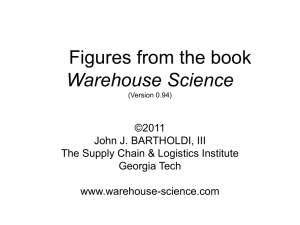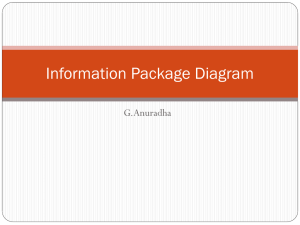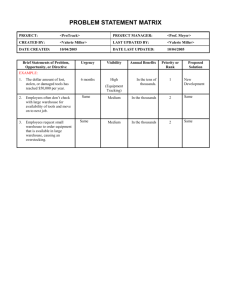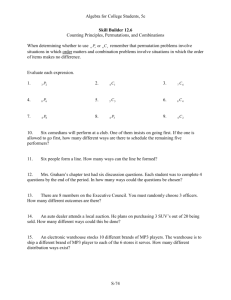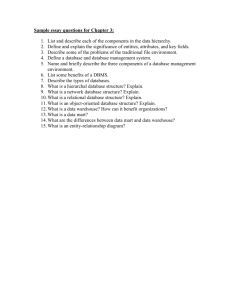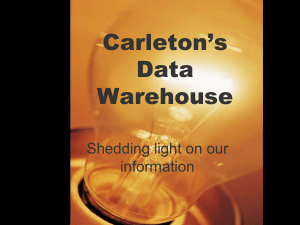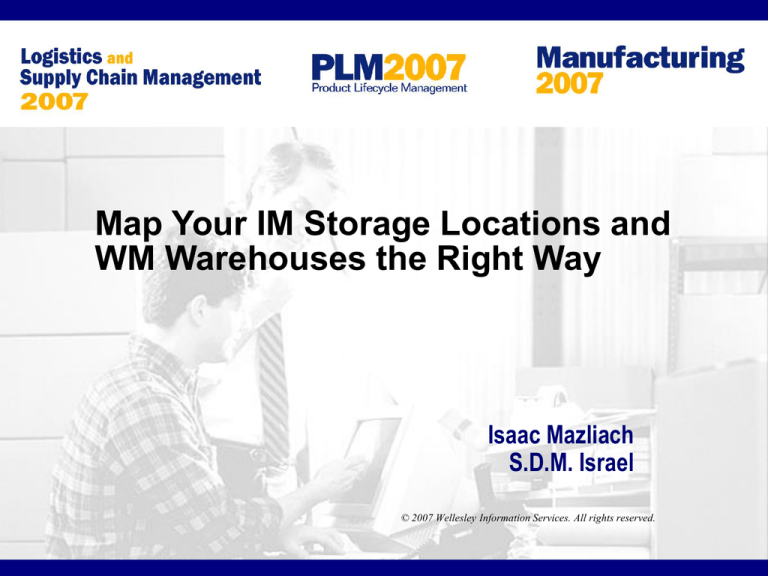
Map Your IM Storage Locations and
WM Warehouses the Right Way
Isaac Mazliach
S.D.M. Israel
© 2007 Wellesley Information Services. All rights reserved.
This Session Will Cover the Mapping of Warehouses and
Storage Locations
• Deciding whether a specific storage place will be
handled as a warehouse [Warehouse Management (WM)]
or as a storage location [Inventory Management (IM)] is
not enough!
• After the completion of that decision, optimize the
relationships at all of the plant’s storage places
• This session will talk about the main differences between
a warehouse and a storage location – and then
recommend the best “mapping” of combined storage
places – WM and IM together to optimize the SAP system
2
What We’ll Cover …
• The storage location as a storage facility
• The warehouse as a storage facility
• Combining storage locations and warehouses
• What is storage location and warehouse mapping?
• Wrap-up
3
Defining “Storage Location”
• Inventory Management is an essential component of
Materials Management and is embedded in the whole
logistics process
• By managing your warehouse stock using Inventory
Management, you will be able to manage your material
stocks in several storage locations in terms of quantity
and value
• Warehouse Management also enables you to display
your entire warehouse complex in the system in detail,
including storage levels. This will be discussed later in
this session.
4
Defining “Storage Location” (cont.)
Material
Requirement
Planning
External Procurement
Purchasing
Internal Procurement
Production
Inventory
Management
Logistics
Execution
Goods Receipt
Transfer Posting
Goods Issue
Warehouse
Management
Shipping
Transfer
Invoice Verification
Sales & Distribution
Internal and External
Accounting
5
Defining “Storage Location” (cont.)
• Storage location is part of SAP’s enterprise structure that
holds the stock quantity
• Option: To maintain a single storage bin for every
material in every storage location
• To simplify: To utilize a storage location as the “storage
facility” means that the material’s actual bin location is
not important, or that the material is located in a single
bin throughout the storage
6
Defining “Storage Location” – Customizing
• IMG > Enterprise structure > Definition > Materials
Management > Maintain storage location
First, define to which
plant the storage
location is created
Second, maintain the
storage locations and
their addresses
7
What is a Storage Location?
Company
Code
Plant
2000
Storage
Location
0001
Plant
1000
Storage
Location
0001
Storage
Location
0002
8
Decision Criteria to Determine the “Storage Facility”
• The storage location should be utilized as the storage
facility if one or more of the following are met:
The storage place is relatively small
There are low levels of inventory on hand
The material handling processes are simple (Goods
Received, Goods Issue, Transfer Posting)
Picking and packing processes should not be managed by SAP
There is a lower volume of activity
Outsourced warehouse operations
9
What We’ll Cover …
• The storage location as a storage facility
• The warehouse as a storage facility
• Combining storage locations and warehouses
• What is storage location and warehouse mapping?
• Wrap-up
10
What is a Warehouse?
• As of SAP R/3 4.5, Warehouse Management is part of
Logistics Execution
• Warehouse Management allows you to implement all of
the processes in Logistics Execution, whether sales
orders have to be fulfilled or production needs to be
supplied with components. Whether goods delivered
from a vendor or finished products from in-house
production have to be put away, Warehouse
Management provides the necessary tools.
11
What is a Warehouse? (cont.)
• Warehouse is part of SAP’s enterprise structure that
holds the stock bin location
• To simplify: When a warehouse (Warehouse
Management) is utilized as a storage facility, a material’s
actual bin location is of great importance
Advantage: Track a material’s changing bin location
• Warehouse Management has greater applications for use
in a storage facility
Disadvantage: More complexity and usually requires more
data entry
12
Defining a Warehouse – Customizing
• IMG > Enterprise structure > Definition > Logistics
Execution > Define … Warehouse number
Copy from standard
Warehouse number 001
13
Defining a Warehouse – Customizing (cont.)
• IMG > Enterprise structure > Assignment > Logistics
Execution > Assign Warehouse number to plant/
storage location
It is possible to
assign more than
one storage
location from
different plants
14
Defining a Warehouse – Customizing (cont.)
• IMG > Logistics Execution > Warehouse
Management > …
• When you copy
Warehouse 001,
most of the
activities will
have default data
• Now it is time
to design your
specific
warehouse
15
What is a Warehouse?
Company
Code
Plant
2000
Plant
1000
Storage
Location
0001
Warehouse 100
Storage
Type
001
Storage
Location
0001
Storage
Location
0002
Storage
Type
002
16
Basic Functions of Warehouse Management
• Warehouse Management in SAP ECC contains the
following five basic functions:
Inventory Management exact to storage bin level
Implementation and control of all goods movements
Monitoring of the processing of these goods movements
Connection to mobile data entry as part of the integrated
Radio Frequency (RF) solution
Connection to specialized external systems using an interface
17
Basic Functions of Warehouse Management (cont.)
• While Inventory Management, as part of Materials
Management, can only provide information on the total
quantity of material in stock, Warehouse Management
enables a precise specification of the exact location of a
particular quantity of material and informs you whether
this quantity is currently in a storage bin or on the move
18
Using the Warehouse as a Storage Facility
• Use the warehouse as the storage place if one or more of
the following are met:
The storage place is relatively large
Large number of materials on hand (e.g., a storage facility
that holds 100,000 materials would mostly be handled as
a warehouse)
Number of transactions (movements) is high
Traceability and visibility is critical
Complex processes
19
What We’ll Cover …
• The storage location as a storage facility
• The warehouse as a storage facility
• Combining storage locations and warehouses
• What is storage location and warehouse mapping?
• Wrap-up
20
Recommendations
• Companies often select only one option: Inventory
Management or Warehouse Management
• If a company is very small, Inventory Management is
often the ideal choice
• In general, if you do not HAVE to implement Warehouse
Management, stick to Inventory Management. Keep
it simple!
• When Warehouse Management is implemented, it is
recommended that storage locations be used according
to processes
21
Recommendations (cont.)
• Goods Receipt from production (Goods Receipt to storage
location, then Transfer Posting to Warehouse Management)
Warehouse
PP Order
915
100
Transfer Posting
to warehouse
902
Storage
Location
0001
Goods Receipt
from production
22
Material Master MRP-2
• Enter the Production
storage location
• Here, enter a storage location
NOT managed by warehouse
• After Goods Receipt from
Production into this storage
location, perform Transfer
Posting (Txn MIGO) to the
warehouse (Movement
Type 311)
23
Goods Issue Using Backflushing
• Goods Issue using Backflushing (Transfer Posting from
Warehouse Management to storage location, then auto
Goods Issue to order)
Storage
912
Warehouse
Location
Transfer Posting
0001
from warehouse
100
Goods Issue
backflushed
material
902
PP Order
24
Automatic Issue to Production Order
This field defines the storage
location from which the
component will be automatically
issued to the production order
This parameter defines that this
component is not issued
manually to the production
order, but rather backflushed
automatically
25
Dispersed Warehouse Locations
• Small locations that reside in different physical
location(s) than the warehouse
Warehouse
912
100
Storage
Storage
Location
Storage
Location
0001
Storage
Location
0002
Location
0003
0004
902
26
QM Integration
• If decentralized Warehouse Management is used with
Quality Management (QM) integration, then QM stock
must reside in a storage location different than the
warehouse
Decentralized
Warehouse
912
Goods
Receipt
Purchase
Order
100
Transfer
Posting
902
QM
Stock
Unrestricted-Use
Stock
Transfer Posting + BAPI (Interface)
27
Special Circumstances
• Some special stocks cannot be implemented in
Warehouse Management (e.g., customer stock as in
Industry Solution – Aerospace & Defense)
In that case – a storage location should be used
Warehouse
912
100
Customer
Stock
902
Transfer
Posting
Customer
Stock
28
What We’ll Cover …
• The storage location as a storage facility
• The warehouse as a storage facility
• Combining storage locations and warehouses
• What is storage location and warehouse mapping?
• Wrap-up
29
Everything You Need to Know About Mapping
• Mapping means the complete landscape of the combined
warehouses and storage locations
• Mapping may change as an enterprise evolves
• Mapping may be created by adding all storage facilities
as boxes on a paper with connecting lines between
all facilities
• The complete mapping should include production
facilities as well as vendors, customers, and other
related systems
30
Goods Receipt (GR) from Purchase Order (PO)
• The connecting lines should introduce a specific
business scenario and its implications, such as
GR to PO
Goods Receipt for materials
with Quality Management
Transaction MIGO
Movement Type 101
Transfer Posting
Transaction QA11
Movement Type 321
Purchase
Order
Goods Receipt for
materials without
Quality Management
Transaction MIGO
Movement Type 101
QM
Stock
Unrestricted-Use
Stock
Purchase
Order
31
Typical Mapping
Purchase
Order
Storage
Location
Warehouse
Storage
Location
Sales
Order
Storage
Location
Storage
Location
Storage
Location
Storage
Location
Storage
Location
Storage
Location
Purchase
Order
Storage
Location
Warehouse
32
The Purposes of Mapping
• High-level definition of business processes
• Basis for authorizations
• Better understanding of “who does what” at a glance
• Minimizing material movement requirements
• Optimizing supply chain processes
33
Examples of Correct Mapping
• Try to have as many materials as possible reside in a
single storage location (if that is not possible – design
an easy process to move the materials from one storage
location to another)
• Design material movements according to SAP’s
available functionality
• Think of information transfer – not only of transactions,
i.e., how would the warehouse know a material should be
transferred from one location to another
The information might transfer by creating a reservation, email,
fax, phone, etc. The transaction would be MIGO Transfer
Posting 311, for instance.
34
Examples of Correct Mapping – Crate Parts
• Different materials (crate parts, pick parts, etc.) behave
differently – design the processes accordingly
Crate Parts: The materials are stored in crates or other
standard containers
These parts are independent of PO and are issued as a
full crate. In the standard system, you order crate
parts manually.
Goods Issue
Transaction MIGO
Movement Type 201
Cost
Center
Goods Issue
Transaction MIGO
Movement Type 261
Unrestricted-Use
Stock
Production
Order
35
Implementing Crate Parts in Warehouse Management
• Create a Control Cycle: SAP Menu > Logistics > Logistics
Execution > Master Data > Warehouse > Control Cycle
Production Supply > Create
On the left, there are the
Staging Indicator Values,
for example, crate part
NOTE: A Control Cycle without material means all materials
EXCEPT those materials with specific Control Cycle
36
Examples of Correct Mapping – Bulk Material
• Bulk material: An item in a Bill of Material (BOM) that is
stored loosely at the work center, ready for use
• Bulk materials are used in small quantities of low value
and are not taken into account when costing an order
Goods Issue
Transaction MIGO
Movement Type 201
Cost
Center
Unrestricted-Use
Stock
X
Production
Order
37
Implementing Bulk Materials – Material Master/BOM
• Bulk material is defined in the Material Master
• NOTE: You may fine-tune and define the bulk materials in
the Bill of Materials (BOM)
Bulk material definition
38
Examples of Correct Mapping – Pick Parts
• Pick Parts: The pick parts are materials that are
provided in the required quantities as specified in a
production order
• These parts can be provided in a physical storage bin or
in a dynamic storage bin, for example, with the name
“Production Order”
Goods Issue
Transaction MIGO
Movement Type 261
Unrestricted-Use
Stock
X
Cost
Center
Production
Order
39
Examples of Incorrect Mapping
• Backflushed material is a material that is issued
automatically to an order after the complete order or
order step is approved (e.g., specific electronic parts
assembled in an SMT machine)
• These parts should be issued from a storage location
Warehouse
912
100
902
Backflushed material
PP Order
40
What We’ll Cover …
• The storage location as a storage facility
• The warehouse as a storage facility
• Combining storage locations and warehouses
• What is storage location and warehouse mapping?
• Wrap-up
41
Resources
• Product information:
www.sap.com/erp
• Product documentation:
http://help.sap.com
• For customers and partners:
http://service.sap.com/qm *
• Information about courses:
www.sap.com/education
* Requires login credentials to the SAP Service Marketplace
42
7 Key Points to Take Home
• Correctly choose which storage facilities would be
handled by Inventory Management and which by
Warehouse Management
• Do not forget to think of your parts categories
Create Master Data accordingly
• Map your entire organization landscape – this will help
you find your wrong decisions
• Avoid incorrect mapping
43
7 Key Points to Take Home (cont.)
• SAP functionality may change your Inventory
Management/Warehouse Management decisions
• Change the mapping as your organization changes
• Consult all modules (not only Materials Management)
when designing the mapping
44
Your Turn!
How to contact me:
Isaac Mazliach
ISAAC@SDM-C.COM
45

